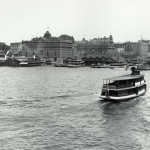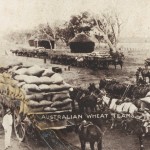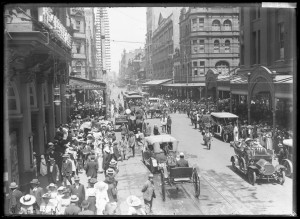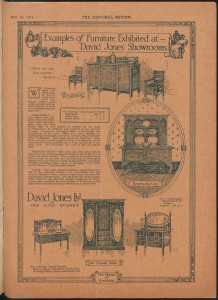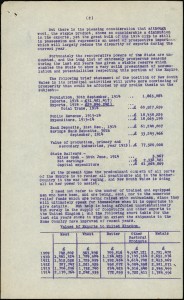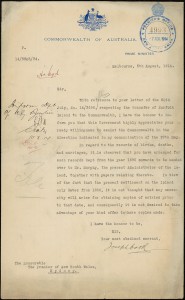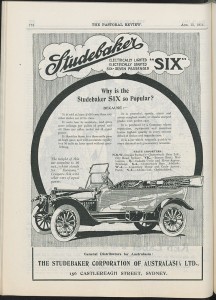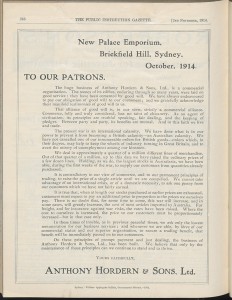Sydney in 1914
The city when war was declared
- 150-170 George Street, Sydney. Digital id 4481_a026_000128[1].
- View looking south towards Circular Quay. Digital id 4481_a026_000495
- Australian wheat harvest. From NRS 20499.
By 1914 the population of Australia had reached nearly five million people and there were 1.8 million people living in New South Wales. Of that 1.8 million, 40% lived in Sydney and the surrounding metropolitan suburbs, making Sydney Australia’s largest city.[1] There would have been a hustle and bustle around the streets of Sydney, with trains and the dockyards evolving to keep up with trading demands.
Import/Export
Trade in imports and exports had been increasing for the last seven or eight years so the state’s outlook was one of “prosperity and progress”.[2] Leading the way were the state’s exports of pastoral products such as butter, meat, wheat and wool, the majority of which were exported to the United Kingdom.[3]
Electric Lighting
On the streets of Sydney electric lighting was replacing the old gas lamps and motor cars jostled with horse drawn carts.
In the home
Electricity hadn’t reached private houses though, so wood and coal fires were used to cook and heat. Ice chests were used as refrigerators and the long drop or backyard toilet was a familiar sight (and smell) for most families.
- a 2lb loaf of bread cost 3 1/2 pence
- a 14lb sack of potatoes cost 1s 1p
- one dozen newly laid eggs cost 1s 6p, and
- a quart of milk cost just over 5s.[4]
Entertainment
At the movies you could see Mary Pickford in Tess of the Storm Country or an Australian film like ‘Neath Australian Skies, produced by Raymond Longford and starring Lottie Lyell at the Crystal Palace or Lyric Theatre in Sydney.[5]
All these films were, of course, silent features and in black and white.
View war time feature film flyers form our collection.
On the sporting field Australian Norman Brookes won Wimbledon, Kingsburgh won the Melbourne Cup, South Sydney won the NSW Rugby Football League and Port Adelaide was the Aussie Rules champion.
Garden Suburb
Daceyville, the Garden Suburb, a new concept for city housing was being built in Sydney’s south east.
Norfolk Island
On 1 July 1914 Norfolk Island was transferred from the NSW government to the Commonwealth government and became an Australian Territory (Fig. 6).
- [Fig. 1 Ad for David Jones, from Pastoral Review, Vol. XXIV, 15 August 1914. NRS 12060 [9/4696 letter 15/729]
- [Fig. 2] ‘New South Wales in 1914’ report. From NRS 12060 [9/4697 letter 15/1430, p.1]
- [Fig. 3] ‘New South Wales in 1914’ report. From NRS 12060 [9/4697 letter 15/1430, p.2]
- [Fig. 4] ‘New South Wales in 1914’ report. From NRS 12060 [9/4697 letter 15/1430, p.3]
- [Fig. 5] Smallpox outbreak in Sydney, 1914. From NRS 906[5/5290 letter 13/15, p.2]
- [Fig. 6] Transfer of Norfolk Island, 1914. From NRS 12060 [9/4692 letter 14/4993]
- [Fig. 7] Ad for Studebaker car from pastoral Review, Vol. XXIV, 15 August 1914. From NRS 12060 [9/4696 letter 15/729, p.778]
- [Fig. 8] Anthony Hordern ad, 1914. From AK698, Vol. VIII No. 11 November 1914, p.366.
Smallpox
As talk of war in Europe grew, storm clouds gathered at home. In the winter of 1914 smallpox again broke out in Sydney, although the strain was not as virulent and not as many people died as in the previous winter (Fig. 5).
Drought and shortages
Severe drought conditions across south-eastern Australia meant that the whole wheat harvest from southern NSW was lost (Fig. 2-4).[6] For the NSW government, the outbreak of war made it:
necessary to exercise the most vigilant care in all departments of the State’s activities to guard against the probable adverse conditions prevailing.[7]
From August to December 1914 trade exports were reduced by 6.5 million pounds.[8] The shortage of ships and war time restrictions, combined with the effects of the drought, hit home. In November 1914 an advertisement for the department store Anthony Hordern & Sons Ltd, claimed that the lowest possible prices for items brought in the pre war period would be maintained (Fig. 8). Hordern also claimed that the store would not:
take advantage of an international crisis, or of a domestic necessity, to ask one penny from our customers.[9]
Unemployment rates were up and many families were struggling on half-wages. With the outbreak of war, families now faced the prospect of fathers, sons and brothers going off to war.
References
(1) Official Year Book of New South Wales, 1914, New South Wales Government, 1915, pp81-85.
(2) State Archives New South Wales: Premier’s Department; NRS 12060 Letters received, [9/4697] 15/1430 p.1.
(3) Ibid.
(4) Official Year Book of New South Wales, 1914, p.882.
(5) SANSW: Colonial Secretary; NRS 905 Main series of letters received [5/7302] 14/49744 and 19/44844.
(6) NRS 12060 [9/4697 ] 15/1430 “New South Wales in 1914” report, p.1.
(7) Ibid.
(8) Ibid.
(9) SANSW: AK698, Education Gazette, Vol. VIII No. 11 November 1914, p.366.


